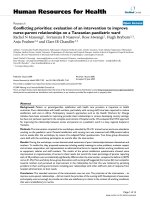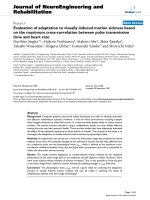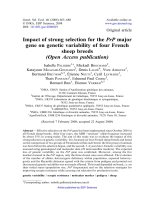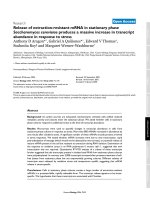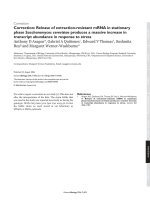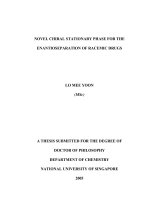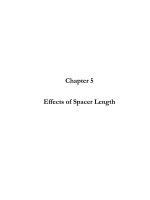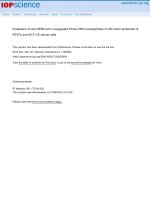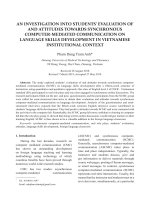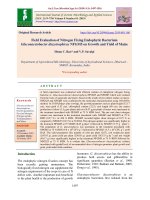High-performance liquid chromatographic evaluation of strong cation exchanger-based chiral stationary phases focusing on stationary phase characteristics and mobile phase effects
Bạn đang xem bản rút gọn của tài liệu. Xem và tải ngay bản đầy đủ của tài liệu tại đây (1.35 MB, 9 trang )
Journal of Chromatography A 1644 (2021) 462121
Contents lists available at ScienceDirect
Journal of Chromatography A
journal homepage: www.elsevier.com/locate/chroma
High-performance liquid chromatographic evaluation of strong cation
exchanger-based chiral stationary phases focusing on stationary phase
characteristics and mobile phase effects employing enantiomers of
tetrahydro-ß-carboline and 1,2,3,4-tetrahydroisoquinoline analogs
Attila Bajtai a, Dániel Tanács a, Róbert Berkecz a, Eniko˝ Forró b, Ferenc Fülöp b,
Wolfgang Lindner c, Antal Péter a, István Ilisz a,∗
a
Institute of Pharmaceutical Analysis, Interdisciplinary Excellence Centre, University of Szeged, H-6720 Szeged, Somogyi utca 4, Hungary
Institute of Pharmaceutical Chemistry, Interdisciplinary Excellence Centre, University of Szeged, H-6720 Szeged, Eötvös u. 6, Hungary
c
Department of Analytical Chemistry, University of Vienna, Währingerstrasse 38, 1090 Vienna, Austria
b
a r t i c l e
i n f o
a b s t r a c t
Article history:
Received 25 February 2021
Revised 25 March 2021
Accepted 28 March 2021
Available online 31 March 2021
In this study, we present results obtained on the enantioseparation of some cationic compounds of pharmaceutical relevance, namely tetrahydro-ß-carboline and 1,2,3,4-tetrahydroisoquinoline analogs. In highperformance liquid chromatography, chiral stationary phases (CSPs) based on strong cation exchanger
were employed using mixtures of methanol and acetonitrile or tetrahydrofuran as mobile phase systems
with organic salt additives.
Keywords:
HPLC
Tetrahydro-ß-carboline analogs
1,2,3,4-tetrahydroisoquinoline analogs
Ion-exchanger chiral stationary phases
Enantioselective separation
Through the variation of the applied chromatographic conditions, the focus has been placed on the study
of retention and enantioselectivity characteristics as well as elution order. Retention behavior of the studied analytes could be described by the stoichiometric displacement model related to the counter-ion effect of ammonium salts as mobile phase additives. For the thermodynamic characterization parameters,
such as changes in standard enthalpy ( H°), entropy ( S°), and free energy ( G°), were calculated
on the basis of van’t Hoff plots derived from the ln α vs. 1/T curves. In all cases, enthalpy-driven enantioseparations were observed with a slight, but consistent dependence of the calculated thermodynamic
parameters on the eluent composition. Elution sequences of the studied compounds were determined
in all cases. They were found to be opposite on the enantiomeric stationary phases and they were not
affected by either the temperature or the eluent composition.
© 2021 The Authors. Published by Elsevier B.V.
This is an open access article under the CC BY license ( />
1. Introduction
Numerous alkaloids, containing tetrahydroisoquinoline (THIQ)
and tetrahydro-β -carboline (THβ C) core including their individual enantiomers, have important pharmacological activity. For example, expectorant emetine (Ipecacuanhe) [1], antitussive noscapine (Papaver somniferum) [2], and Trabectidine marketed as Yondelis® (Ecteinascidia turbinate) [3], show anticancer effect. Liensinine (Nelumbo nucifera) [4], saframycine A (Myxococcus xanthus)
[5], and other synthetic THIQ analogs such as Zalypsis® [6], have
promising pharmaceutical activities toward HIV or cancer. THβ C
alkaloids, originated from both natural and synthetic sources, have
∗
Corresponding author at: István Ilisz, Institute of Pharmaceutical Analysis, University of Szeged, H-6720 Szeged, Somogyi utca 4, Hungary.
E-mail address: (I. Ilisz).
also been investigated intensively in drug research. For instance,
vincristine, vinblastine [7], and reserpine [8] are used in the therapies of cancer or hypertension. Callophycine A (Callophycus oppositifolius) [9] has cytotoxic, harmicine (Kopsia Griffithii) [10] exhibits
antinociceptive, and (+)-7-bromotypargine (Ancorina sp.) shows
antimalarial activity [11], whereas Tadalafil (Cialis®) was successfully applied in the treatment of erectile dysfunction [12]. In the
course of the synthesis and stereochemical characterization of
these compounds, enantioselective chromatographic protocols have
to be integrated as well.
Accordingly, for such direct chromatographic enantiomer separation techniques appropriate chiral stationary phases (CSPs) and
chiral columns need to be applied. In several review articles [1317] the most popular methods applied for enantiomeric resolutions
in both analytical and preparative scales have been discussed. In
addition to the highly popular polysaccharide-based selectors (SOs)
/>0021-9673/© 2021 The Authors. Published by Elsevier B.V. This is an open access article under the CC BY license ( />
A. Bajtai, D. Tanács, R. Berkecz et al.
Journal of Chromatography A 1644 (2021) 462121
Fig. 1. Structure of chiral strong cation exchanger-type stationary phases.
Fig. 2. Structure of analytes, tetrahydro-β -carboline (THβ C, 1–3) and tetrahydroisoquinoline (THIQ, 4–6) analogs.
[16-21], unique chiral cation- and zwitterion-type ion exchangerbased SOs and CSPs have also been developed in the last decade
[22-26] to provide solutions for the resolution of charged analytes.
Recently, enantioseparation of some related THIQ derivatives
was carried out on new CSPs based on chiral crown ethers [27],
polysaccharides [28-32], and Cinchona alkaloids [32,33]. Compared
to the THIQ analogs, there are relatively few literature data on the
HPLC enantioseparations of chiral THβ C derivatives. Direct methods were based on the application of macrocyclic glycopeptides
[34,35], polysaccharides [31,32,36,37], Cinchona alkaloids [32], and
strong cation exchanger-based SOs [37].
In this study five novel, chiral strong cation exchangers (cSCXs),
based on varied 3,5-disubstituted benzoic acids functionalized
with trans-(R,R)- and trans-(S,S)-2-aminocyclohexanesulfonic acid
(Fig. 1), have been evaluated for the enantiodiscrimination of six
pairs of chiral amine-type analytes (Fig. 2) in order to gather information about the underlying cation exchange process [22,24].
This type of SOs can be operated under mild, often MS-compatible
polar organic mobile phase conditions consisting of MeOH, MeCN
and/or THF as organic solvents together with acidic and basic additives.
In consideration of previous results with respect to efficient
separation of some ß-carboline derivatives [37], the focus of the
present study is on a systematic study of the enantioseparation
of the newly synthetized three THIQ and three THßC derivatives
(Fig. 2) and a comparison of separation performances obtained
with the cSCX-type CSPs (Fig. 1). Detailed investigations have been
carried out to evaluate the effects of the composition of the polar organic mobile phase, the nature of additives, the amount and
nature of the counter-ion, the specific structural features of the analytes (SAs) and SOs, as well as the temperature on retention, selectivity, and resolution of the stereoisomers. Since the configura-
tions of all chiral analytes are known, the elution sequences were
determined in all cases.
2. Materials and methods
2.1. Chemicals and reagents
On the basis of recent results on the enantioselective acylation of 1-alkyl-substituted THIQ [38] and THβ C [39], asymmetric N-alkoxycarbonylations of racemic 1-substituted THIQ and
THβ C with phenyl allyl carbonate were carried out utilizing Candida antarctica lipase B in di-2-propylether (iPr2 O) at 60°C (E >
200). The alkoxycarbonylation process provided enantiomers of 1methyl- (1A and 1B), 1-ethyl- (2A and 2B), 1-propyl- (3A and 3B)
THβ C and 1-methyl- (4A and 4B), 1-ethyl- (5A and 5B), 1-propyl(6A and 6B) THIQ. The unreacted (S) enantiomers (1B–6B) as well
as their antipods (1A–6A) were prepared through the enzymatic
hydrolysis of the (R)-carbamates resulting in products with high
enantiomeric excess (> 97%).
Acetonitrile (MeCN), methanol (MeOH), tetrahydrofuran (THF)
of HPLC grade, and ammonium formate (HCOONH4 ), ammonium
acetate (NH4 OAc), triethylamine (TEA), formic acid (FA), acetic acid
(AcOH) of analytical reagent grade were purchased from VWR International (Radnor, PA, USA). Ultrapure water was obtained from
Ultrapure Water System, Puranity TU UV/UF (VWR International).
2.2. Apparatus and chromatography
To perform liquid chromatographic measurements, a Waters
Breeze system consisting of a 1525 binary pump, a 2996 photodiode array detector, a 717 plus autosampler, and Empower 2 data
manager software (Waters Corporation, Milford, MA, USA) was applied. A Lauda Alpha RA8 thermostat (Lauda Dr. R. Wobser Gmbh,
2
A. Bajtai, D. Tanács, R. Berkecz et al.
Journal of Chromatography A 1644 (2021) 462121
Lauda-Königshofen, Germany) was employed to maintain constant
column temperature.
All analytes were dissolved in MeOH in the concentration range
0.5–1.0 mg mL−1 and 20-μL samples were injected. The dead-times
of the columns were determined by injecting acetone dissolved in
MeOH. Experiments, unless otherwise stated, were carried out in
isocratic mode at a flow rate of 0.6 mL min−1 and column temperature of 25°C. The synthesis of the cSCX-type CSPs based on
different 3,5-disubstituted benzoic acids functionalized with trans(R,R)- and trans-(S,S)-2-aminocyclohexanesulfonic acids as chiral
SOs and ion exchange units has already been described [24]. The
structures of DCL-(R,R), DCL-(S,S), DML-(R,R), DML-(S,S), and DCL(S,S)-MP CSPs, including the bonding chemistry onto silica is depicted in Fig. 1. All columns employed have the same physical size
(150 × 4.0 mm I.D., 5-μm particle size).
to the different hydrogen-bonding properties of the solvents. In the
present study, the change of MeCN to THF revealed a significant
effect on the retention behavior of the basic target analytes as visualized in Fig. 4. Namely, starting from a mobile phase containing
100% MeOH (in addition to 25 mM TEA and 50 mM FA) with increasing THF content k1 first decreased and then after about 50%
THF content it increased considerably (Fig. 4). A similar behavior
was observed earlier with basic and acidic analytes on zwitterionic
CSPs [40].
A comparison of Fig. 4 and Fig. 3 reveals that applying THF instead of MeCN as a co-solvent in MeOH, the retention profiles of
analytes have a different shape. The observed retention factors are
based on concerted multiple interactions between the SAs and the
SO, which depend on the size of the solvation shells of all charged
interaction sites of SO and SAs. The solvation shells of the charged
compounds, in addition to their physical and chemical properties,
will also be affected by both the acid and basic additives and the
solvent mixture applied as mobile phase. Consequently, the observed retention behavior represents a rather complex situation.
Based on data discussed above, an exact and validated explanation cannot be provided here. Therefore, it can only be hypothesized that the larger sizes of the solvation shells of the charged
sites with a solvent component of higher acidity present in the
eluent will influence the strength of the SO–SA electrostatic interactions resulting in lower retention factors. Simultaneously, the
elution strength of the counter-ion is also affected by the mobile
phase composition; i.e., the larger the size of the solvation shell
of the counter-ion, the lower its eluent strength will be, affording higher retention times. Since the retention will be the result
of these two opposite effects, the measured retention times might
increase or decrease with higher protic solvent ratios in the eluent, thus leading to a U-shape retention curve. Naturally, additional
stereoselective SO–SA interactions will also be affected by the solvent composition, thus the observed α values may change, as it
can also be deduced from Fig. 3 and Fig. 4. As expected, all these
effects depend on the analyte and may somewhat be different for
the THβ C and THIQ analogs. To validate this hypothesis, further
experiments are planned to be performed.
These cSCX columns, in principle, can be operated with diverse
amines in their protonated forms as counter-ions leading to conditions more compatible with MS [24]. As a consequence, further
experiments with MeOH/MeCN and MeOH/THF bulk solvents containing NH4 OAc as salt additive instead of TEA–FA mixtures were
carried out. The effects of the bulk solvent composition were investigated for analytes 1–6 varying the MeOH/MeCN or MeOH/THF
ratio between 100/0 and 20/80 (v/v) in the presence of 60 mM
NH4 OAc. Results are visualized in Fig. S1 and Fig. S2. The retention
behavior was similar to that of the MeOH/THF system applying
TEA/FA additives with k1 exhibiting a minimum curve upon changing MeOH/MeCN or MeOH/THF ratios. Interestingly, chiral discrimination for analytes 1–3 was independent of the MeOH/MeCN ratio, α remained practically constant, while in resolution a slight increase was observed with increasing MeCN content (Fig. S1). THIQ
analogs could not be resolved under these conditions.
A comparison of the four cSCX columns linked with “triazole”
revealed that under all studied conditions, at least partial separation could be achieved on all columns for the THßC analogs. The
two 3,5-dichloro-substituted DCL-(R,R) and DCL-(S,S) type SOs and
related columns exhibit particularly high separation performances
for analytes 1–3 with resolutions ranging between 2.2–6.1. The two
3,5-dimethoxy-substituted SOs leading to a π -basic aryl moiety
were less effective in the separation of THßC analogs; namely, k1 ,
α , and RS were markedly smaller with the DML columns under
identical conditions. For a set of experiments applying DCL-(S,S)MP with MeOH/MeCN containing NH4 OAc eluents the linkage type
of the DCL SOs was also probed. The obtained results (data not
3. Results and discussions
The compounds employed in this study are analogs of
tetrahydro-ß-carboline and 1,2,3,4-tetrahydroisoquinoline. The
three-ring THßC and two-ring THIQ parent compounds have different structural features, while the alkyl (methyl, ethyl, propyl)
substitution in both types of analytes and the presence of methoxy
group on THIQ afford additional structural differences. The secondary amino group in protonated (ionic) form renders electrostatic interaction with SOs of opposite charge. The calculated
pKa values of secondary amino groups of analytes 1–6 are 9.16,
9.29, 9.30, 8.89, 9.04, and 9.06, respectively. (Calculations were
performed with the Marvin Sketch v. 17.28 software, ChemAxon
Ltd., Budapest.) The calculated pKa values of the amino group in
the pyrrole moiety for analyte 1–3 were above 16, i.e., no protonation can be expected under the applied conditions. All these
structural features may contribute to the different noncovalent
SO–SA interactions and chiral recognition characteristics.
3.1. Effect of mobile phase composition on chromatographic
performances
On cSCX columns, the primary driving force for retention is
the formation of ion-pairs via long-range electrostatic interactions
between the protonated amino group of the SAs and the deprotonated aminocyclohexanesulfonic acid moiety of the SO. These
work in cooperation with additional short-range noncovalent interactions such as H-bonding, dipole–dipole, π –π , and steric interactions [22,24,37]. As reported previously, cSCX columns afforded
the best results when mixtures of MeOH (as polar protic solvent)
and MeCN (as polar, but aprotic solvent) are applied in the presence of a weak organic base and a weak organic acid providing an
overall slight acidity to the mobile phase [22,24]. On the basis of
our preliminary experiments, the enantioseparation of THßC and
THIQ analogs on the studied cSCX CSPs was first carried out with
the application of MeOH and MeCN or THF as bulk solvents in different ratios containing base and acid additives.
First, the effects of the bulk solvent composition were investigated for analytes 1–6 by varying the MeOH/MeCN ratio between
100/0 and 25/75 (v/v), in the presence of 25 mM TEA and 50 mM
FA. As illustrated in Fig. 3, for the k1 values of all studied analytes significant increases were registered with increasing MeCN
contents. The observed changes in the retention of THßC analogs
were especially high compared to those of the THIQ analogs. These
mobile phase systems were highly effective in the enantioseparation of THßC analogs (especially with DCL type CSPs). Regarding α
and RS values, they increased markedly for the THßC analogs, but
THIQ analogs were not separable under these conditions. As found
earlier [26], the change of the polar but aprotic MeCN to THF may
substantially affects the chiral discrimination of basic analytes due
3
A. Bajtai, D. Tanács, R. Berkecz et al.
Journal of Chromatography A 1644 (2021) 462121
Fig. 3. Effects of mobile phase composition on the retention factor of the first-eluting enantiomer (k1 ), the separation factor, (α ) and resolution (RS ).
Chromatographic conditions: columns, DCL-(S,S), DCL-(R,R), DML-(S,S), and DML-(R,R); mobile phase, MeOH/MeCN (100/0, 75/25, 50/50, and 25/75 v/v) all containing 25 mM
TEA and 50 mM FA; flow rate, 0.6 ml min−1 ; detection, 220–250 nm, temperature, 25 °C; symbols, for analyte 1, , for 2, , for 3, ◦, for 4, , for 5, , for 6, •.
shown in detail) provided evidence for an additional SO–SA interaction effect of the “triazole” linkage over the mercaptopropylbonding chemistry in the case of THßC analogs. The “triazole” moiety probably takes part in chiral discrimination through H-bonding
interaction and its application results in higher retention and improved enantioselectivity.
exchange mechanisms. As Eq. (1) shows, the model predicts that
the logarithm of the retention factor is linearly related to the logarithm of the counter-ion concentration,
log k = log KZ − −Z log ccounter−ion
(1)
where Z=m/n, the ratio of the number of charges of the cation and
the counter-ion and Kz is related to the ion-exchange equilibrium
constant. That is, the log k vs. log ccounter-ion function shows a linear relationship, where the slope of the line is proportional to the
effective charge during ion exchange, while the intercept carries
information about the equilibrium constant of ion exchange.
3.2. Effect of the counter-ion concentration
The stoichiometric displacement model [41] is most often used
to describe the retention behavior based on ion-pairing and ion4
A. Bajtai, D. Tanács, R. Berkecz et al.
Journal of Chromatography A 1644 (2021) 462121
Fig. 4. Effects of mobile phase composition on the retention factor of the first-eluting enantiomer (k1 ), for the separation factor (α ), and resolution (RS ).
Chromatographic conditions: columns, DCL-(S,S), DCL-(R,R), DML-(S,S), and DML-(R,R); mobile phase, MeOH/THF (100/0, 75/25, 50/50, 25/75, and 10/90 v/v) all containing 25
mM TEA and 50 mM FA; flow rate, 0.6 ml min−1 ; detection, 220–250 nm, temperature, 25 °C; symbols, for analyte 1, , for 2, , for 3, ◦, for 4, , for 5, , for 6, •.
Applying a mobile phase of MeOH/MeCN (50/50 v/v) in the
presence of NH4 OAc in the ion-pairing process, the protonated ammonium ion acts as a competitor. The effects of variation of the
concentration of the counter-ion on retention for analytes 1–3 on
three cSCX CSPs [DCL-(S,S), DCL-(S,S)-MP, and DCL-(R,R)] are depicted in Fig. S3. Under the studied conditions, linear relationships
were found between log k1 vs. log ccounter-ion with slopes varying
between (–0.86)–(–0.97). The observed slopes around –1.0 were
not significantly affected by the linkage chemistry of the applied
CSPs and they correspond well to the values found for different
amines examined on cation-exchanger-type CSPs [22].
Varying the type of the counter-ion using mixtures of TEA
and AcOH (i.e., triethylammonium ion served as a counter-ion),
slopes (Fig. S4) and enantioselectivities rather similar to those with
NH4 OAc were obtained. What becomes evident, however, is the effect of the type of the counter-ion (ammonium ion vs triethylammonium ion) on the retention behavior. At similar eluent compositions (MeOH/MeCN 50/50 v/v), the ammonium ion leads to much
smaller retention factors (data not shown). This might be explained
by the effect of the size of the solvated counter-ion. The smaller
the size of the solvated counter-ion, the closer it can get to the
ion-exchanger site and its elution ability will be the stronger. It is
5
A. Bajtai, D. Tanács, R. Berkecz et al.
Journal of Chromatography A 1644 (2021) 462121
Table 1
Effects of eluent composition
tetrahydroisoquinoline analogs.
on
chromatographic
data
k1 ,
α , RS of tetrahydro-ß-carboline and 1,2,3,4-
Analyte
k1 , α , RS
Column
MeOH/MeCN
MeOH/THF
Column
MeOH/MeCN
MeOH/THF
1
k1
DCL-(S,S)
36.24(S)
1.20
4.15
28.13(S)
1.23
4.69
26.40(S)
1.26
5.19
12.00 (S)
1.13
3.07
10.41 (S)
1.14
3.68
10.16 (S)
1.15
3.71
27.34(R)
1.18
3.99
21.76(R)
1.21
4.94
20.47(R)
1.23
5.34
16.60(S)
1.17
3.09
11.69(S)
1.22
3.93
10.16(S)
1.27
4.62
7.81 (S)
1.10
2.56
6.01 (S)
1.14
3.32
5.46 (S)
1.16
3.68
13.54(R)
1.14
3.00
9.68 (R)
1.19
3.98
8.43 (R)
1.22
4.65
DML-(S,S)
4.65 (S)
1.06
0.56
3.96 (S)
1.07
0.92
3.62 (S)
1.08
0.96
22.07 (R)
1.07
1.66
18.22 (R)
1.09
2.22
16.80 (R)
1.10
2.31
2.49 (S)
1.09
0.71
1.93 (S)
1.10
0.88
1.66 (S)
1.10
1.07
10.03 (R)
1.08
1.55
7.48 (R)
1.11
2.17
6.41 (R)
1.12
2.35
2
3
1
2
3
1
2
3
α
RS
k1
α
RS
k1
α
RS
k1
α
DCL-(S,S)-MP
RS
k1
α
RS
k1
α
RS
k1
α
RS
k1
α
RS
k1
α
RS
DCL-(R,R)
DML-(R,R)
Chromatographic conditions: columns, DCL-(R,R), DCL-(S,S), DML-(R,R), DML-(R,R), DCL-(R,R)-MP; mobile phase,
MeOH/MeCN (25/75 v/v) or MeOH/THF (25/75 v/v) both containing 25 mM TEA and 50 mM FA; flow rate, 0.6 ml min–1
detection at 223 or 230 nm; temperature, 25°C; (R) or (S), configuration of the first-eluting enantiomer.
important to keep in mind that the size of the solvated counterion depends not only on the size of the protonated amine, but also
on the eluent composition (see earlier discussion). The aprotic solvent is a poor solvating agent for the cation resulting in a thinner
solvation shell which, in turn, will enable stronger electrostatic interactions. Because of rather limited data, our hypothesis must not
necessarily be generalized; therefore, the screening of the effect of
the type and size of the amine used as counter-ion will necessary
be performed.
of the side chain; however, the separation factor remained practically constant (data not shown). According to the slight increase
of the pKa values of analytes 1 to 3, the retention order based on
only electrostatically driven interactions, should be 3<2<1. In the
present case, in contrast, it is actually reversed, because it is outbalanced by the sterically driven size effect.
It is important to mention that the elution order was not influenced by the size of the substituent, i.e., ion pair formation plays a
decisive role in the chiral discrimination through multisite interactions in synergy with steric effects.
A comparison of separation performances of THßC and THIQ
analogs revealed that THßC derivatives could efficiently be separated on cSCX CSPs. The THIQ analogs were less retained than
THßC derivatives and were not separable on cSCX phases under
the applied conditions (Table 1). The elution sequences observed
on the studied cSCX phases follow the general rule determined by
the configuration of the chiral moiety of the SO. That is, in all studied mobile phases on CSPs possessing (S,S)-configuration, the elution sequence was S < R, while on CSPs with (R,R)-configuration
it was R < S (Table 1). It can also be extracted from Table 1 that
the two DCL(S,S) SO-based columns slightly differ in their retention
and stereoselectivity characteristics under identical mobile phase
conditions. On the one hand, this can be accounted for by their
different binding chemistries. On the other hand, the other factor
is the slightly higher loading of selector DCL(S,S) compared to that
of DCL(S,S)-MP.
3.3. Structure–retention relationships and elution sequences
In organic chemistry, the steric effect of a substituent pattern
on the reaction rate of a particular reaction scenario had been
characterized by Meyer with the so-called size descriptor (Meyer
parameter, Va ) [42]. Accordingly, to gain a deeper understanding
of the effect of alkyl substituents of the investigated SAs, we attempted to investigate a relationship between the Meyer parameter and the chromatographic characteristics. The effect of alkyl
side-chain was studied with mobile phases of different compositions on the four cSCX columns. Data obtained in MeOH/MeCN
and MeOH/THF (25/75 v/v) mobile phases, all containing 25 mM
TEA and 50 mM FA, are depicted in Fig. S5. The corresponding results show a linear relationship for k1 vs. Va with good correlation
coefficients (R2 ≥ 0.991). Therefore, it can be concluded that, for
the present case, the retention clearly depends on the volume of
the alkyl side chain. With increasing Meyer parameters (increasing volume of the substituents of analytes 1–3 and 4–6) retention
decreased correspondingly, while stereoselectivity increased on all
cSCXs. Through a steric effect, a bulkier substituent, to a certain
extent, can evidently inhibit the selective interactions formed between SA and SO leading to a reduced retention under the given
mobile phase conditions. The application of mobile phases containing NH4 OAc as additive instead of TEA and FA (see above) showed
similar retention behavior: k1 depended strongly on the bulkiness
3.4. Temperature dependence and thermodynamic study
The investigation of the temperature dependence of chromatographic characteristics is a possible way to map the retention
mechanism, since thermodynamic parameters can provide valuable
information about the processes that play a key role in the retention mechanism.
6
A. Bajtai, D. Tanács, R. Berkecz et al.
Table 2
Thermodynamic parameters
Analyte
1
2
3
1
2
3
1
2
3
1
2
3
1
2
3
1
2
3
Journal of Chromatography A 1644 (2021) 462121
( So ), T ×
( Ho ),
Mobile phase
a
b
c
d
e
f
( So ),
( Go ), correlation coefficients (R2 ), and Q values of ß-carboline analogs on DCL-(S,S) columns.
– ( H ) (kJ/mol)
– ( S ) (J/(mol∗ K)
Correlation coefficients (R2 )
–T ×
1.41
1.39
1.42
1.48
1.55
1.68
1.56
1.82
1.97
1.66
1.53
1.49
1.83
1.70
1.74
1.94
1.94
2.10
3.75
3.60
3.63
3.96
3.98
4.27
4.16
4.66
4.90
4.45
3.99
3.84
4.91
4.39
4.47
5.06
4.89
5.24
0.995
0.996
0.997
0.994
0.996
0.997
0.994
0.996
0.994
0.994
0.995
0.997
0.995
0.995
0.996
0.976
0.960
0.957
1.12
1.07
1.08
1.18
1.19
1.27
1.24
1.39
1.46
1.33
1.19
1.14
1.46
1.31
1.33
1.51
1.46
1.56
o
o
( So )298K (kJ/mol)
– ( Go )298K (kJ/mol)
Q
0.29
0.32
0.34
0.30
0.36
0.40
0.32
0.43
0.50
0.33
0.34
0.35
0.37
0.39
0.41
0.43
0.49
0.54
1.3
1.3
1.3
1.3
1.3
1.3
1.3
1.3
1.3
1.3
1.3
1.3
1.3
1.3
1.3
1.3
1.3
1.3
Chromatographic conditions: column, DCL-(S,S); mobile phase, a, MeOH/THF (75/25 v/v) containing 50 mM FA and 25 mM TEA, b, MeOH/THF (50/50 v/v) containing
50 mM FA and 25 mM TEA, c, MeOH/THF (25/75 v/v) containing 50 mM FA and 25 mM TEA, d, MeOH/MeCN (75/25 v/v) containing 50 mM FA and 25 mM TEA, e,
MeOH/MeCN (50/50 v/v) containing 50 mM FA and 25 mM TEA, f, MeOH/MeCN (25/75 v/v) containing 50 mM FA and 25 mM TEA; flow rate, 0.6 ml min–1 ; detection,
218–280 nm; Q = ( H°)/298 × ( S°).
Fig. 5. Selected chromatograms of tetrahydro-ß-carboline analogs.
Chromatographic conditions: columns, DCL-(S,S); mobile phase, MeOH/THF (25/75 v/v) all containing 25 mM TEA and 50 mM FA; flow rate, 0.6 ml min−1 ; detection, 220–250
nm, temperature, 10°C.
Applying the van’t Hoff representation, as suggested by Chester
and Coym [43] the difference in the change in standard enthalpy
( H°) and entropy ( S°) for the two enantiomers can be calculated on the basis of Eq. (2)
ln α = −
( H◦ )
RT
+
( S◦ )
R
mental data are listed in Table S1, while the calculated thermodynamic parameters are summarized in Table 2. Under all applied
chromatographic conditions, retentions decreased with increasing
temperature for all studied THßC analogs. The transfer of the SA
from the mobile phase to the stationary phase is an exothermic
process and k1 decreases with increasing temperature. Changes observed in α and RS were also consistent: both α and RS decreased
with increasing temperature. The calculated thermodynamic parameters were all negative indicating that the adsorption is preferential from view of the enthalpy term, while it is unfavorable
from view of the entropy term. Data varied in a relatively narrow
range: ࢞(࢞H°) ranged from –1.41 to –2.10 kJ mol–1 , ࢞(࢞S°) varied between–3.60 to –5.24 J mol–1 K–1 , while ࢞(࢞G°) ranged from
–0.29 to –0.54 kJ mol–1 . The relative contribution of the enthalpic
and entropic terms to the free energy of adsorption is reflected in
the enthalpy/entropy ratios Q=࢞(࢞H°)/298 × ࢞(࢞S°) (Table 2). In
all studied cases, Q was higher than one, i.e., the separations were
enthalpically driven independently from the applied mobile phase
systems. Systematic studies for exploring how the chromatographic
conditions affect the thermodynamic parameters are rare to find.
Very recently Asnin and co-workers investigated the enantioselective separation of some dipeptides applying macrocyclic antibioticbased (Chirobiotic R and T) CSPs reporting correlation between
࢞H°, ࢞S° or ࢞G° and the mobile phase pH or MeOH content
[46,47]. As can be seen from data given in Table 2, all calculated
thermodynamic parameters changed monotonically with the eluent composition in both the MeOH/MeCN and the MeOH/THF mobile phase systems. The calculated thermodynamic parameters became increasingly negative for all three analogs with decreasing
(2)
where T is the absolute temperature (K), and R is the universal gas
constant. Since the contribution of nonselective interactions cannot be extracted only by subtracting the appropriate thermodynamic parameters (or in a “chromatographic way”), it is important
to emphasize that the thermodynamic data presented here cover
apparent values from a combination of enantioselective and nonselective interactions. Keeping the limitations of this approach in
mind, the evaluation based on the chromatographic characteristics obtained under the same conditions (given stationary phase,
mobile phase with constant composition, constant flow rate [44])
in the case of compounds showing significant structural analogy
still can provide useful information for a better understanding of
the molecular recognition mechanism. The pitfalls of the thermodynamic calculations were excellently summarized by Asnin and
Stepanova [45].
To explore the effects of temperature on the chromatographic
parameters, a variable temperature study was carried out in the
temperature range 10–50°C (at 10°C increments) on the bestperforming DCL-(S,S) CSP employing the THßC analogs. To gather
information about the effects of the mobile phase composition on
the thermodynamic parameters, six different eluent compositions
were tested, in duplicates at each studied temperature. Experi7
A. Bajtai, D. Tanács, R. Berkecz et al.
Journal of Chromatography A 1644 (2021) 462121
MeOH content in both systems, suggesting that the difference between the sum of the enantioselective and non-selective processes,
related to the adsorption and desorption steps of the enantiomers,
became higher in eluents of lower MeOH content. A further exploration of the effect of eluent composition on the binding affinity of
ionic CSPs requires additional studies with zwitterionic CSPs.
Selected chromatograms for the illustration of the best enantioseparations are depicted in Fig. 5.
Supplementary materials
Supplementary material associated with this article can be
found, in the online version, at doi:10.1016/j.chroma.2021.462121.
References
[1] E.M. Boyd, L.M. Knight, The expectorant action of cephaeline, emetine and
2-dehydroemetine, J. Pharm. Pharmacol. 16 (1964) 118–124, doi:10.1111/j.
2042-7158.1964.tb07430.x.
[2] M.A. Al-Yahya, M.M.A. Hassan, Noscapine, Anal. Profiles Drug Subst. 11 (1982)
407–461, doi:10.1016/S0099- 5428(08)60271- 3.
[3] A. Poveda, I. Ray-Coquard, I. Romero, J.A. Lopez-Guerrero, N. Colombo, Emerging treatment strategies in recurrent platinum-sensitive ovarian cancer: focus
on trabectedin, Cancer Treat. Rew. 40 (2014) 366–375, doi:10.1016/j.ctrv.2013.
08.001.
[4] Y. Kashiwada, A. Aoshima, Y. Ikeshiro, Y.-P Chen, H. Furukawa, M. Itoigawa,
T. Fujioka, K. Mihashi, L.M. Cosentino, S.L. Morris-Natschke, K.-H. Lee, Anti-HIV
benzylisoquinoline alkaloids and flavonoids from the leaves of Nelumbo nucifera, and structure-activity correlations with related alkaloids, Bioorg. Med.
Chem. 13 (2005) 443–448, doi:10.1016/j.bmc.2004.10.020.
[5] Z.-Z. Liu, Y. Wang, Tang Y.-F, S.-Z. Chen, X.-G. Chen, H.-Y. Li, Synthesis and antitumor activity of simplified ecteinascidin–saframycin analogs, Bioorg. Med.
Chem. Lett. 16 (2006) 1282–1285, doi:10.1016/j.bmcl.2005.11.069.
[6] J.F.M. Leal, V. García-Hernández, V. Moneo, A. Domingo, J.A. Bueren-Calabuig,
A. Negri, F. Gago, M.J. Guillén-Navarro, P. Avilés, C. Cuevas, L.F. GarcíaFernández, C.M. Galmarini, Molecular pharmacology and antitumor activity of
Zalypsis® in several human cancer cell lines, Biochem. Pharmacol. 78 (2009)
162–170, doi:10.1016/j.bcp.20 09.04.0 03.
[7] Z.-J. Zhang, J. Yang, J. He, X.-D. Wu, L.-D. Shao, Y. Li, S.-X. Huang, R.-T. Li, Q.S. Zhao, Vincamajorines A and B, monoterpenoid indole alkaloids with new
carbon skeletons from Vinca major, Tetrahedron Lett 55 (2014) 6490–6494,
doi:10.1016/j.tetlet.2014.10.011.
[8] H.-J. Cong, Q. Zhao, S.-W. Zhang, J.-J. Wei, W.-Q. Wang, L.-J. Xuan, Terpenoid
indole alkaloids from Mappianthus iodoides Hand.-Mazz, Phytochemistry 100
(2014) 76–85, doi:10.1016/j.phytochem.2014.01.004.
[9] T.-S. Kam, K.-M. Sim, Alkaloids from Kopsia griffithii, Phytochemistry 47 (1998)
145–147, doi:10.1016/S0 031-9422(97)0 0513-X.
[10] R.A. Davis, S. Duffy, V.M. Avery, D. Camp, J.N.A. Hooper, R.J. Quinn, (+)7-Bromotrypargine: an antimalarial β -carboline from the Australian marine
sponge Ancorina sp, Tetrahedron Lett 51 (2010) 583–585, doi:10.1016/j.tetlet.
2009.11.055.
[11] S. Xiao, X.-X. Shi, J. Xing, J.-J. Yan, S.-L. Liu, W.-D. Lu, Synthesis of tadalafil
(Cialis) from l-tryptophan, Tetrahedron: Asymmetry 20 (2009) 2090–2096,
doi:10.1016/j.tetasy.2009.07.048.
[12] S. He, P.H. Dobbelaar, L. Guo, Z. Ye, J. Liu, T. Jian, Q. Truong, S.K. Shah, W. Du,
H. Qi, R.K. Bakshi, Q. Hong, J.D. Dellureficio, E. Sherer, A. Pasternak, Z. Feng,
M. Reibarkh, M. Lin, K. Samuel, V.B. Reddy, S. Mitelman, S.X. Tong, G.G. Chicchi, K.-L. Tsao, D. Trusca, M. Wu, Q. Shao, M.E. Trujillo, G. Fernandez, D. Nelson,
P. Bunting, J. Kerr, P. Fitzgerald, P. Morissette, S. Volksdorf, G.J. Eiermann, C. Li,
B.B. Zhang, A.D. Howard, Y.-P. Zhou, R.P. Nargund, W.K. Hagmann, SAR exploration at the C-3 position of tetrahydro-β -carboline sstr3 antagonists, Bioorg.
Med. Chem. Lett. 26 (2016) 1529–1535, doi:10.1016/j.bmcl.2016.02.022.
[13] M. Lämmerhofer, Chiral recognition by enantioselective liquid chromatography: Mechanisms and modern chiral stationary phases, J. Chromatogr. A 1217
(2010) 814–856, doi:10.1016/j.chroma.2009.10.022.
[14] B. Chankvetadze, Recent developments on polysaccharide-based chiral stationary phases for liquid-phase separation of enantiomers, J. Chromatogr. A 1269
(2012) 26–51, doi:10.1016/j.chroma.2012.10.033.
[15] G.K.E. Scriba, Chiral recognition in separation science – an update, J. Chromatogr. A 1467 (2016) 56–78, doi:10.1016/j.chroma.2016.05.061.
[16] G.K.E. Scriba, Chiral recognition in separation sciences. Part I: Polysaccharide
and cyclodextrin selectors, TrAC Trends Anal. Chem. 120 (2019) 115639, doi:10.
1016/j.trac.2019.115639.
[17] B. Chankvetadze, Recent trends in preparation, investigation and application
of polysaccharide-based chiral stationary phases for separation of enantiomers
in high-performance liquid chromatography, TrAC - Trends Anal. Chem. 122
(2020) 115709, doi:10.1016/j.trac.2019.115709.
[18] R. Sardella, F. Ianni, A. Lisanti, M. Marinozzi, S. Scorzoni, B. Natalini, The effect
of mobile phase composition in the enantioseparation of pharmaceutically relevant compounds with polysaccharide-based stationary phases, Biomed. Chromatogr. 28 (2014) 159–167, doi:10.1002/bmc.3015.
[19] A.E. Dascalu, A. Ghinet, B. Chankvetadze, E. Lipka, Comparison of dimethylated
and methylchlorinated amylose stationary phases, coated and covalently immobilized on silica, for the separation of some chiral compounds in supercritical fluid chromatography, J. Chromatogr. A 1621 (2020) 461053, doi:10.1016/j.
chroma.2020.461053.
[20] F. Ianni, F. Blasi, D. Giusepponi, A. Coletti, F. Galli, B. Chankvetadze, R. Galarini,
R. Sardella, Liquid chromatography separation of alpha- and gamma-linolenic
acid positional isomers with a stationary phase based on covalently immobilized cellulose tris(3,5-dichlorophenylcarbamate), J. Chromatogr. A 1609 (2020)
460461, doi:10.1016/j.chroma.2019.460461.
[21] G. D’Orazio, C. Fanali, S. Fanali, A. Gentili, B. Chankvetadze, Comparative study on enantiomer resolving ability of amylose tris(3-chloro-5methylphenylcarbamate) covalently immobilized onto silica in nano-liquid
4. Conclusions
In this comprehensive investigation the enantioseparation of
tetrahydro-ß-carboline and 1,2,3,4-tetrahydroisoquinoline analogs
were carried out utilizing chiral strong cation exchangers. Focusing
on the retention behavior, the applicability of stoichiometric displacement model was confirmed using mixtures of methanol with
acetonitrile or tetrahydrofuran as mobile phase systems with organic salt additives. The nature (size) of counter-ion was found to
be an important factor markedly affecting retention, while it had
much less effect on the observed enantioselectivities. A hypothesis based on the size of the solvated counter-ion is applied consistently for the description of the observed retention characteristics;
however, it needs further approval.
Since elution orders in every case were found to be opposite
on the enantiomeric stationary phases and they were not affected
by either the temperature or the eluent composition, the developed methods can easily be employed for the effective enantioresolution of the studied tetrahydro-ß-carboline analogs. The enantiomers of 1,2,3,4-tetrahydroisoquinoline analogs could not be separated under the applied conditions. The temperature-dependence
study revealed enthalpically driven recognitions in all cases, where
the calculated thermodynamic parameters were slightly dependent
on the eluent composition.
This study also demonstrates the consistent use of appropriate chiral cation exchangers working as CSPs for liquid chromatography of basic analytes with mobile phase conditions compatible
with LC-MS applications.
Declaration of Competing Interest
Authors declare no conflict of interest.
CRediT authorship contribution statement
Attila Bajtai: Investigation, Writing - original draft, Visualization. Dániel Tanács: Investigation, Writing - original draft, Visualization. Róbert Berkecz: Writing - review & editing. Eniko˝ Forró:
Resources, Writing - original draft. Ferenc Fülöp: Writing - review
& editing. Wolfgang Lindner: Conceptualization, Writing - review
& editing. Antal Péter: Conceptualization, Writing - original draft.
István Ilisz: Conceptualization, Writing - review & editing, Supervision, Project administration, Funding acquisition.
Acknowledgements
This work was supported by the project grant GINOP-2.3.2-152016-0 0 034 and the ÚNKP-20-3 new national excellence program
of the Ministry for Innovation and Technology from the source of
National Research, Development and Innovation Fund. The Ministry
of Human Capacities, Hungary grant TKP-2020 is also acknowledged. The authors highly acknowledge Michal Kohout (Department of Organic Chemistry, University of Chemistry and Technology Prague) and Denise Wolrab (Department of Analytical Chemistry, University of Vienna) for the chiral columns.
8
A. Bajtai, D. Tanács, R. Berkecz et al.
[22]
[23]
[24]
[25]
[26]
[27]
[28]
[29]
[30]
[31]
[32]
[33]
Journal of Chromatography A 1644 (2021) 462121
chromatography and capillary electrochromatography, J. Chromatogr. A 1606
(2019) 460425, doi:10.1016/j.chroma.2019.460425.
C.V. Hoffmann, M. Lämmerhofer, W. Lindner, Novel strong cation-exchange
type chiral stationary phase for the enantiomer separation of chiral amines by
high-performance liquid chromatography, J. Chromatogr. A 1161 (2007) 242–
251, doi:10.1016/j.chroma.2007.05.092.
C.V. Hoffmann, R. Pell, M. Lämmerhofer, W. Lindner, Anal. Chem. 80 (2008)
8780–8789, doi:10.1021/ac801384f.
D. Wolrab, P. Frühauf, M. Kohout, W. Lindner, Click chemistry immobilization strategies in the development of strong cation exchanger chiral stationary
phases for HPLC, J. Sep. Sci. 36 (2013) 2826–2837, doi:10.10 02/jssc.20130 0559.
I. Ilisz, N. Grecsó, M. Palkó, F. Fülöp, W. Lindner, A. Péter, Structural and
temperature effects on enantiomer separations of bicyclo[2.2.2]octane-based
3 amino-2-carboxylic acids on Cinchona alkaloid-based zwitterionic chiral stationary phases, J. Pharmaceut. Biomed. 98 (2014) 130–139, doi:10.1016/j.jpba.
2014.05.012.
N. Grecsó, M. Kohout, A. Carotti, R. Sardella, B. Natalini, F. Fülöp, W. Lindner,
A. Péter, I. Ilisz, Mechanistic considerations of enantiorecognition on novel Cinchona alkaloid-based zwitterionic chiral stationary phases from the aspect of
the separation of trans-paroxetine enantiomers as model compounds, J. Pharmaceut. Biomed. 124 (2016) 164–173, doi:10.1016/j.jpba.2016.02.043.
A. Lee, H.J. Choi, K.B. Jin, M.H. Hyun, Liquid chromatographic resolution of 1aryl-1,2,3,4-tetrahydroisoquinolines on a chiral stationary phase based on (+)(18-crown-6)-2,3,11,12-tetracarboxylic acid, J. Chromatogr. A 1218 (2011) 4071–
4076, doi:10.1016/j.chroma.2011.04.088.
H. Kazoka, O. Rotkaja, L. Varaceva, Enantioseparation of 1-phenyl-1,2,3,4tetrahydroisoqunoline on polysaccharide-based chiral stationary phases, Chromatographia 73 (2011) S123–S129, doi:10.1007/s10337- 011- 1991- 9.
I. Ilisz, Z. Gecse, I. Szatmári, F. Fülöp, A. Péter, High-performance liquid chromatographic enantioseparation of naphthol-substituted tetrahydroisoquinolines on polysaccharide-based chiral stationary phases, Biomed. Chromatogr.
28 (2014) 142–151, doi:10.10 02/bmc.30 02.
N. Grecsó, I. Ilisz, Z. Gecse, L. Schưnstein, F. Fülöp, A. Péter, High-performance
liquid chromatographic enantioseparation of amino alcohol analogues possessing 1,2,3,4-tetrahydroisoquinoline skeleton on polysaccharide-based chiral
stationary phases, Biomed. Chromatogr. 29 (2015) 788–796, doi:10.1002/bmc.
3363.
A. Bajtai, G. Lajkó, G. Németi, I. Szatmári, F. Fülöp, A. Péter, I. Ilisz, Highperformance liquid chromatographic and subcritical fluid chromatographic
separation of α -arylated ß-carboline, N-alkylated tetrahydroisoquinolines and
their bioisosteres on polysaccharide-based chiral stationary phases, J. Sep. Sci.
42 (2019) 2779–2787, doi:10.10 02/jssc.20190 0228.
I. Ilisz, A. Bajtai, I. Szatmári, F. Fülưp, W. Lindner, A. Péter, Enantioseparation
of ß-carboline, tetrahydroisoquinoline, and benzazepine analogues of pharmaceutical importance: utilization of chiral stationary phases based on polysaccharide and sulfonic acid modified Cinchona alkaloids in high-performance liquid and subcritical fluid chromatography, J. Chromatogr. A 1615 (2020) 460771,
doi:10.1016/j.chroma.2019.460771.
I. Ilisz, N. Grecsó, F. Fülưp, W. Lindner, A. Péter, High-performance liquid
chromatographic enantioseparation of cationic 1,2,3,4-tetrahydroisoquinoline
analogs on Cinchona alkaloid-based zwitterionic chiral stationary phases, Anal.
Bioanal. Chem. 407 (2015) 961–972, doi:10.10 07/s0 0216- 014- 8247- 0.
[34] A. Péter, G. Tưrưk, G. Tóth, W. Van Den Nest, G. Laus, D. Tourwé, D.W. Armstrong, Enantiomeric separation of unusual secondary aromatic amino acids,
Chromatographia 48 (1998) 53–58, doi:10.1007/BF02467516.
[35] A. Péter, G. Török, D.W. Armstrong, High-performance liquid chromatographic
separation of enantiomers of unusual amino acids on a teicoplanin chiral stationary phase, J. Chromatogr. A 793 (1998) 283–296, doi:10.1016/
S0 021-9673(97)0 0938-2.
[36] E. Lipka, S. Yous, C. Furman, P. Carato, C. Deghaye, J.-P. Bonte, C. Vacher, Analytical and preparative chiral separation of ß-carboline derivatives, LDL oxidation
inhibitors, using HPLC and CE methodologies: Determination of enantiomeric
purity, Chromatographia 75 (2012) 337–345, doi:10.1007/s10337- 012- 2194- 8.
[37] G. Lajkó, N. Grecsó, R. Megyesi, E. Forró, F. Fülưp, D. Wolrab, A.Péter W.Lindner,
I. Ilisz, Enantioseparation of ß-carboline derivatives on polysaccharide- and
strong cation exchanger-based chiral stationary phases. A comparative study,
J. Chromatogr. A 1467 (2016) 188–198, doi:10.1016/j.chroma.2016.05.040.
[38] B. Kovács, R. Megyesi, E. Forró, F. Fülưp, Efficient lipase-catalysed route for
the kinetic resolution of salsolidine and its ß-carboline analogue, TetrahedronAsymmetr 28 (2017) 1829–1833, doi:10.1016/j.tetasy.2017.10.019.
[39] B. Kovács, E. Forró, F. Fülưp, Candida antarctica lipase B catalysed kinetic resolution of 1,2,3,4-tetrahydro-ß-carbolines: Substrate specificity, Tetrahedron 74
(2018) 6873–6877, doi:10.1016/j.tet.2018.10.034.
[40] N. Grecsó, E. Forró, F. Fülưp, A. Péter, I. Ilisz, W. Lindner, Combinatorial effects of the configuration of the cationic and the anionic chiral subunits of
four zwitterionic chiral stationary phases leading to reversal of elution order
of cyclic ß3 -amino acid enantiomers as ampholytic model compounds, J. Chromatogr. A 1467 (2016) 178–187, doi:10.1016/j.chroma.2016.05.041.
[41] W. Kopaciewicz, M.A. Rounds, F. Fausnaugh, F.E. Regnier, Retention model for
high-performance ion-exchange chromatography, J, Chromatogr, A 266 (1983)
3–21, doi:10.1016/S0021-9673(01)90875-1.
[42] A.Y. Meyer, Molecular mechanics and molecular shape. Part 4. Size, shape, and
steric parameters, J. Chem. Soc. Perkin Trans. 2 (1986) 1567–1572, doi:10.1039/
P29860 0 01567.
[43] T.L. Chester, J.W. Coym, Effect of phase ratio on van’t Hoff analysis in
reversed-phase liquid chromatography, and phase-ratio-independent estimation of transfer enthalpy, J. Chromatogr. A 10 03 (20 03) 101–111, doi:10.1016/
S0 021-9673(03)0 0846-X.
[44] A. Sepsey, É. Horváth, M. Catani, A. Felinger, The correctness of van ’t Hoff
plots in chiral and achiral chromatography, J. Chromatogr. A. 460594 (2020)
1611, doi:10.1016/j.chroma.2019.460594.
[45] L.D. Asnin, M.V. Stepanova, Van’t Hoff analysis in chiral chromatography, J. Sep.
Sci. 41 (2018) 1319–1337, doi:10.1002/jssc.201701264.
[46] E.N. Reshatova, M.V. Kopchenova, S.E. Vozisov, A.N. Vasyanin, L.D. Asnin, Enantioselective retention mechanism of dipeptides on antibiotic-based chiral stationary phases: Leucyl-leucine, glycyl-leucine, and leucyl-glycine as case studies, J. Chromatogr. A. 1602 (2019) 368–377, doi:10.1016/j.chroma.2019.06.025.
[47] L.D. Asnin, M.V. Kopchenova, S.E. Vozisov, M.A. Klochkova, Y.A. Klimova, Enantioselective retention mechanism of dipeptides on antibiotic-based chiral stationary phases. Effect of the methanol content in the mobile phase, J. Chromatogr. A. 1626 (2020) 461371, doi:10.1016/j.chroma.2020.461371.
9
